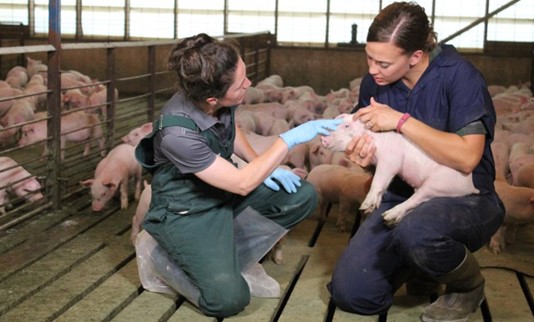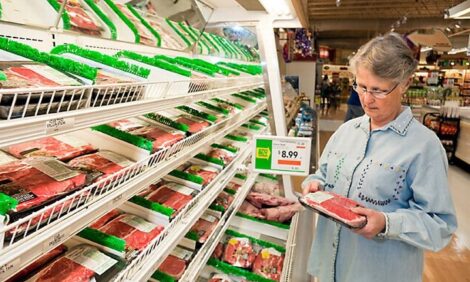



¿Hablas español? New livestock veterinary training teaches students to communicate with their clients
Colorado State University has launched a new undergraduate certificate in “Spanish for Animal Health and Care“ to make sure students in veterinary and animal science fields are equipped to communicate after they graduate and begin working with Spanish speakers in a farm or ranch settingWhen Noa Roman-Muniz was interning at CSU’s Veterinary Teaching Hospital in 2001 and visiting local dairy farms, she noticed that managers were giving instructions to workers in English, but many of the employees were foreign-born Spanish speakers who clearly didn’t understand.
“Communication in animal care is important, because you might be talking about where you give a cow an injection, and that location affects how long the medicine is in the cow’s system, and how well that medicine will work,” she explains. “So it’s about human and animal health and safety, as well as food quality.”

Accurate communication is crucial to maintaining animal health and the productivity of a unit. Image: Deb Murray, We Care
Roman-Muniz says the specialised medical language needed in animal health care covers everything from disease diagnosis and treatment to feeding, milking, birthing and preventive medicine.
The new certificate will be offered by the Department of Languages, Literatures and Cultures beginning this fall, and will be available in an online-only format as well as in person. It is the brainchild of instructor Shannon Zeller and Professor Maura Velázquez-Castillo in the department, who were introduced to the problem by Roman-Muniz.
“A certificate like this is long overdue, and producers are excited about it,” says Roman-Muniz, who is now an associate professor in the Department of Animal Sciences and a CSU Extension dairy specialist. “Our students are well-trained in the science, but producers need employees who can manage and communicate with people.”
About the certificate
Sometimes a Spanish speaker who knows a little bit of English – or an English speaker who knows some Spanish – will get designated as the farm’s translator, but if they’re not fluent in both languages, misunderstandings can happen. Roman-Muniz, who is bilingual, says she witnessed a situation in which a farm manager was attempting to explain employee benefits like health insurance and vacation time, but the translation was inaccurate and workers were getting ready to quit until she stepped in to translate accurately.
“We should not be relying on a worker who happens to know a little bit of English,” she says. “For example, if there’s only one translator, that person has a lot of power. He might not translate the message accurately, and there can be distrust among co-workers.”
Improved communication can also lead to better understanding and appreciation of other cultures and people who don’t look like you, Roman-Muniz explains. Plus, miscommunication can lead to a mass exodus of Spanish-speaking workers.
“I’ve gotten calls from farms asking if we at CSU can help find people to milk their cows because several workers just walked out due to a misunderstanding,” she says. “Students sometimes think they can just use Google Translate during their careers, but you can get into trouble. Our students need to be equipped to deal with multicultural populations.”
Roman-Muniz, who took a class on language teaching methodology from Velázquez-Castillo more than a decade ago, lauded the fact that the new certificate programme is not just about language, but also about culture. The first two courses address field-specific language functions and terminology for routine and complex workplace tasks. The third course is a more in-depth exploration of word formation mechanisms and terminology in equine care as well as dairy and beef livestock establishments. The culminating course brings it all together by applying the students’ linguistic skills to cultural aspects of diverse workplaces.
“The focus on culture in that last course will cover themes like cultural displacement, workplace cohesion and power relations around gender, age and ethnicity,” Zeller says.
Students will need to have some basic familiarity with Spanish before taking the coursework, the equivalent of about two years’ worth, she notes. Those not already enrolled at CSU can take the programme and receive a “master’s badge” instead of a certificate upon completion through CSU Online.
Additional plans include extending Spanish instruction in the College of Veterinary Medicine and Biomedical Sciences – a series of four one-credit courses – to meet the needs of future rural and small-animal veterinarians. And CSU’s third-year veterinary students can now take a 20-hour, third-year practicum in Spanish language instruction, an intensive language immersion workshop that is highly recommended for students applying to travel to the CSU center Todos Santos, Mexico, for a veterinary externship programme.

The "Spanish for Animal Health and Care" course will be available to students both enrolled and not enrolled at Colorado State University
“As a land-grant university that houses prestigious veterinary and animal sciences programmes, CSU is uniquely positioned to be a pioneer in these types of interdisciplinary research and curricular partnerships, which cater to the real-life language needs of future professionals in those fields,” Velázquez-Castillo says. “The collaborative nature of this project provides the College of Liberal Arts and the Department of Languages, Literatures and Culture the opportunity to partake in groundbreaking interdepartmental research and curricular development in hybrid and online formats so that resident students, field professionals and students from other universities will benefit.”
Click here to find out more









